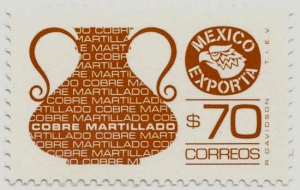The copper industry in Mexico embraces two extremes: from a major Mexican multinational, Grupo México, to hundreds of dedicated, but poorly remunerated coppersmiths living in a small town in Michoacán.
Large-scale copper mining in Mexico
Grupo México is the largest mining corporation in Mexico, and the world’s third largest copper producer. The company has faced a series of financial and labor issues over the years, which have sometimes restricted its output. It operates two major mines in Mexico, both in the northern part of the state of Sonora:
- Cananea – this mine, which dates back to 1899, produced 163,804 tons of copper in 2006. It has some of the largest reserves in the world.
- La Caridad – proven reserves of 600 million metric tons.
Grupo Peñoles started extracting copper from the Milpillas copper deposit, also in Sonora, in 2006. Copper miens in Sonora account for 83% of national output. Other states where copper is mined include:
- Zacatecas (6%), where copper is one of several metals obtained from Industrial Minera México’s mine at Sombrerete
- Chihuahua (4%), where copper is mined at Santa Bárbara and Naica.
- San Luis Potosí (6%), where copper comes from the polymetallic mine of Charcas (also Industrial Minera México)
- minor amounts are also obtained in Durango, Hidalgo, Michoacán, the State of México and Sinaloa.
335,000 tons of copper were mined in 2007
The artisans of Santa Clara del Cobre are justly world-famous for their coppersmithing skills.
A great time to visit the town, one of Mexico’s Magical Towns, is during the annual Copper Fair. The XLV National Copper Fair and LXV Hammered Copper Competition run from 7-17 August 2010. The competition offers 89 prizes with a total prize fund of 414,000 pesos (33,000 dollars).
How did Santa Clara, in Michoacán, come to be associated with copper working?
In pre-colonial times, local Indians mined for copper in various regions of Mexico including the state of Michoacan in Central Mexico, where the local P’urhepecha Indian group produced magnificent copper, gold and silver jewelry. They also made copper handaxes, used as currency throughout MesoAmerica.
In 1538, the Spanish missionary, Vasco de Quiroga, the first Bishop of Michoacan, helped develop local crafts. To avoid competition between villages, he encouraged each village to specialize in a particular craft. Coppersmithing was the craft allocated to Santa Clara (now Santa Clara del Cobre).
Santa Clara became the most prominent copper-producing town in colonial New Spain. During the 17th century, the town was the main source for hand-hammered copper kettles.In the 20th century, when demand for these collapsed, the townspeople, supported by government programs, started making a variety of other objects.
A National Copper Fair was started, and state-sponsored coppersmithing competitions began. Santa Clara de Cobre has a museum dedicated to copper working, where many of the prize-winning entries from previous years are displayed.
Further artistic and commercial impetus to Santa Clara copper came in the 1970s from American James Metcalf and his Mexican wife Ana Pellicer. Metcalf created the Olympic torch for the 1968 Mexico City Olympic Games.
While most copper pieces are designed to be utilitarian, the number of decorative items has increased in recent decades, with many items incorporating other metals, stone and ceramics. Many of the workshops continue to employ traditional techniques; a single hand-crafted piece may take an entire month to make.
The economy of coppersmithing
About 82% of households in Santa Clara depend on copper working for their livelihood. The town has more than 300 workshops. Between them, they transform 450 tons of copper a year. In an average year, sales of copper items reach about 4 million dollars.
Smelting the copper in colonial times required large quantities of charcoal. Charcoal production contributed greatly to the region’s deforestation.
The industry depends on recycled copper wire and cable, which in some years includes imports from the USA. One of the great ironies of this is that American tourists now visit Santa Clara to buy back (admittedly at a much higher price and in a more artistic form) the same copper they once threw away.
When electricity was first brought to Santa Clara, it is said that the electric company had a hard time keeping the lines functioning as they were often stolen to be hammered into copper posts and pans for the next market day.
Curiosity
Perhaps Santa Clara’s most famous son is J. Jesús Pérez Gaona, better known as “Pito Pérez”. Born in 1867, he began studying to be a priest, but never completed his studies. He then became a clerk, a drunkard and—mainly—a wonderful dreamer. He was immortalized in Rubén Romero’s great work, “La vida inútil de Pito Pérez” (The useless life of Pito Pérez), later turned into a movie.
Mexico’s mining sector is analyzed in chapter15 of Geo-Mexico: the geography and dynamics of modern Mexico. Buy your copy of this invaluable reference guide today!
2 Responses to “Copper products, exports and handicrafts in Mexico”
Sorry, the comment form is closed at this time.

Hello
I am interested in purchasing copper vases, pots trays and such, Can anyway direct me to a contact person for this wholesale purchase? Thank you, Myles
Our two favorite major workshops/stores there, both of which are highly recommended and enjoy a thriving international market for their products, are:
1. Casa Felícitas (Pino Suarez No. 88, Santa Clara del Cobre, Michoacan).
Tel 011-52 (434) 343-0443, fax (434) 343-0043; sorry, I’ve mislaid their e-mail address.
2. El Portón (Owner: Juan José Paz)
website
In my opinion, Casa Felicitas has slightly higher quality (and is slightly more expensive) than El Portón, but either firm should be able to supply whatever you need.